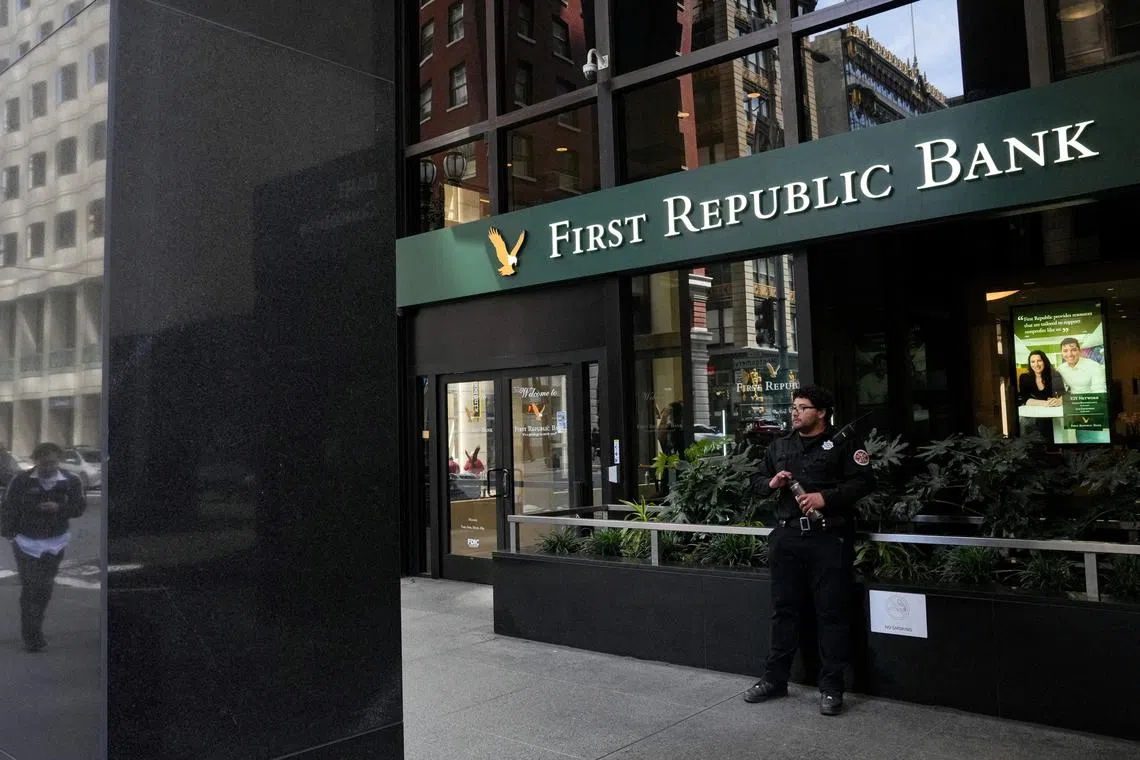First Republic seized by US regulators, to be sold to JPMorgan
Sign up now: Get ST's newsletters delivered to your inbox

JPMorgan will take over First Republic’s assets, including about US$173 billion (S$230 billion) of loans, US$30 billion of securities, and US$92 billion in deposits.
PHOTO: REUTERS
Follow topic:
NEW YORK - First Republic Bank was taken over by regulators
JPMorgan will take over First Republic’s assets, including about US$173 billion (S$230 billion) of loans and US$30 billion of securities, as well as US$92 billion in deposits.
JPMorgan and the Federal Deposit Insurance Corp (FDIC), which orchestrated the sale, agreed to share the burden of losses, as well as any recoveries, on the firm’s single-family and commercial loans, the agency said on Monday.
“Our government invited us and others to step up and we did,” JPMorgan chief executive Jamie Dimon said in a statement. “Our financial strength, capabilities and business model allowed us to develop a bid to execute the transaction in a way to minimise costs to the Deposit Insurance Fund.”
The transaction makes JPMorgan, the nation’s largest bank, even more massive – an outcome government officials have taken pains to avoid in the past.
Because of United States regulatory restrictions, JPMorgan’s size and its existing share of the US deposit base would prevent it, under normal circumstances, from expanding its deposit base further. And prominent Democratic lawmakers and the Biden administration have chafed at consolidation in the financial industry and other sectors.
JPMorgan expects to recognise a one-time gain of US$2.6 billion tied to the transaction, according to a statement. The bank estimated it will incur US$2 billion in related restructuring costs over the next 18 months.
The US$92 billion in deposits includes the US$30 billion that JPMorgan and other large US banks put into the beleaguered First Republic in March to try to stabilise its finances. JPMorgan vowed that the US$30 billion would be repaid.
For the US$173 billion in loans and US$30 billion in securities included in the deal, JPMorgan and the FDIC entered into the loss-sharing agreement to cover single-family residential mortgage loans and commercial loans, as well as US$50 billion worth of five-year, fixed-rate term financing.
Another wrinkle: JPMorgan was a key player throughout First Republic’s struggles. The bank advised its smaller rival in its attempt to find strategic alternatives, and Mr Dimon was key in marshalling bank executives to inject US$30 billion in deposits into First Republic to shore up its finances amid heavy withdrawals in March.
First Republic specialises in private banking that caters to wealthier people, much like Silicon Valley Bank (which failed in March) focused on venture capital firms. Chairman Jim Herbert started the lender in 1985 with fewer than 10 people, according to a First Republic history. By July 2020, the bank said it ranked as the 14th largest in the US, with 80 offices in seven states. It employed more than 7,200 people at the end of 2022.
Like other regional lenders, First Republic found itself squeezed
The result was a capital hole big enough to deter a full-scale rescuer from stepping forward. A fresh round of concern was set off in April by the bank’s first-quarter report and news of its attempt to sell assets and engineer a rescue. The bank said it would cut as much as 25 per cent of its staff, lower outstanding loans and curb non-essential activities.
Eleven US banks had tried to keep First Republic afloat by pledging US$30 billion of fresh deposits on March 16, with JPMorgan, Bank of America, Citigroup and Wells Fargo pitching in US$5 billion each. Goldman Sachs Group and Morgan Stanley and other banks offered smaller amounts as part of a plan devised along with US regulators. On top of that, First Republic tapped the Federal Home Loan Bank Board and a Federal Reserve liquidity line.
It was not enough. The stock, which topped US$170 in March 2022, sank below US$5 by late April. First Republic’s demise would imperil not only common share owners, but also about US$3.6 billion of preferred shares and US$800 million of unsecured notes.
The bank has been bought and sold several times over the years, with Merrill Lynch paying US$1.8 billion to acquire First Republic in 2007. Ownership passed to Bank of America when it bought Merrill Lynch in 2009, and changed hands again in mid-2010, when investment firms including General Atlantic and Colony Capital purchased First Republic for US$1.86 billion and then took it public. BLOOMBERG

